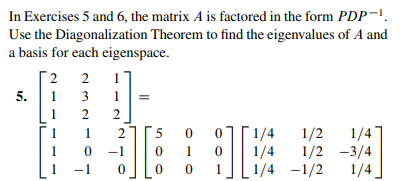Nemanjavuk69
Junior Member
- Joined
- Mar 23, 2022
- Messages
- 71
Hello
I am reading up on linear algebra and its applications 6 global edition by David C. Lay.
I am at chapter 5.3 where it talks about eigenvalues and eigenspace, and I am trying to solve excercise number 5 (Please look at the attached image file)

I also know that the answer is λ=5:⎣⎢⎡111⎦⎥⎤
λ=1:⎣⎢⎡10−1⎦⎥⎤,⎣⎢⎡2−10⎦⎥⎤
My question is now, where does the basis(answer) come from? Can anyone show me a computation of how the basis are being calculated? I seem to always get another basis when solving it myself.
I am reading up on linear algebra and its applications 6 global edition by David C. Lay.
I am at chapter 5.3 where it talks about eigenvalues and eigenspace, and I am trying to solve excercise number 5 (Please look at the attached image file)

I also know that the answer is λ=5:⎣⎢⎡111⎦⎥⎤
λ=1:⎣⎢⎡10−1⎦⎥⎤,⎣⎢⎡2−10⎦⎥⎤
My question is now, where does the basis(answer) come from? Can anyone show me a computation of how the basis are being calculated? I seem to always get another basis when solving it myself.
